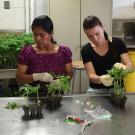This project provides information and strategies to improve tomato and pepper production through the use of grafting and low/high tunnel technologies among smallholder growers in Kirinyaga District, Kenya.
Tomato and pepper production are important sources of household income and nutrition. Their production is poised to increase in the region if production systems are made more efficient by minimizing the onset of frequent and highly disruptive crop stresses (e.g., disease, nutrient and/or water deficiency/excess) and providing greater returns to farmer time and effort. Using grafted plants and low/high tunnels reduces crop stress and eases labor requirements in vegetable production around the globe. Interest in grafting and low/high tunnels is rising in Kenya and the region. However, the availability of regional resources — including materials and human capacity — is undocumented, and guidance for farmers in these tools is lacking.
Led by Matthew Kleinhenz, this international team documents baseline resources available in Kirinyaga District for using grafting and low/high tunnels. Then the team develops educational products and programs designed to increase stakeholder success in the use of these tools. These products and programs are tested and evaluated as foundational components in larger regional efforts.
Deliverables and related resources
- Tomato Grafting Guide (PDF) for September 2011 workshop with additional distribution
- Grafting and tunnels project poster (PDF) presented April 2011 at Horticulture CRSP annual meeting
- Vegetable Grafting, a website with research-based information with funding from USDA-NIFA
- Grafting Guide, a PDF publication from The Ohio State University team
- Vegetable Grafting in Africa: Status and Outlook, a short PowerPoint in PDF
- Baseline survey results of stakeholders using grafting and tunnels in tomato production (PDF)

